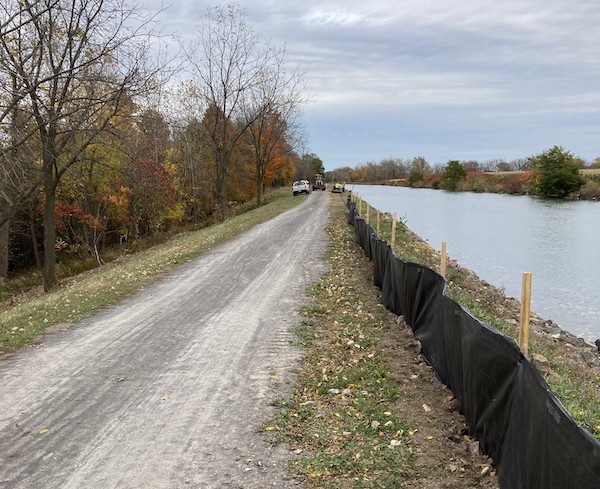Canal Corp. working on embankment in Royalton that has been prone to seepage

Photo courtesy of the NYS Canal Corp. – Construction has started on a canal embankment in Royalton. A soil-bentonite slurry wall will be installed between Wruck Road and Peet Street.
Press Release, NYS Canal Corp.
ROYALTON – The New York State Canal Corporation announced that a construction project to address persistent seepage along the Erie Canal’s earthen embankment in the Town of Royalton, Niagara County has commenced.
The Canal Corporation and its contractors will install a soil-bentonite slurry wall along a one-half mile stretch of the earthen embankment underneath the centerline of the Erie Canalway Trail between Wruck Road and Peet Street. This project is the first of its kind to be initiated under the Canal Corporation’s Earthen Embankment Integrity Program (EEIP) that was implemented after completing an extensive State Environmental Quality Review (SEQR) in December 2022.
“As stewards of the historic Erie Canal, it is incumbent upon us to ensure that the waterway’s infrastructure continues to operate safely for generations to come,” said New York State Canal Corporation Director Brian U. Stratton. “This project in Royalton and future investments in the earthen embankments that carry the canal high above surrounding communities are integral components of maintaining the longevity of the Canal system.”
The Canal Corporation has been monitoring three known seeps, or leaks, along this half-mile rural stretch on the north side of the Erie Canal for more than 20 years. Due to dense vegetation that had grown on the outboard slope of the earthen embankment, the Canal Corporation’s maintenance staff were previously unable to fully inspect this location for additional seeps. In the spring of 2021, after clearing all three-inch or less in diameter vegetation, 14 additional seeps were uncovered.
Upon this discovery, a “filter blanket,” comprised of layers of sand and gravel earthen material, was installed to mitigate water that was seeping through the embankment. In addition, the Canal Corporation began monitoring the embankment daily.
In October of 2021, a 176-foot-long limited depth clay cut-off wall was installed at this location to slow down the seeps after a sinkhole along the Erie Canalway Trail that sits atop of the embankment was discovered.
Building upon the initial clay cut-off wall and to seal the earthen embankment, over the next several weeks, a soil-bentonite slurry wall will be installed into the full depth of the embankment, in places 30-feet deep to bedrock, by Hohl Industrial Services, Inc. of Tonawanda and DeWind of Zeeland, Michigan using DeWind’s “One-Pass Trenching Technology.”
This technology allows a trench in the embankment to be excavated while simultaneously mixing the existing, in-place soil with a hydrated bentonite slurry that is pumped in. Once cured, the soil-bentonite cut-off wall provides a permanent underground wall or barrier to water. Utilizing this machinery allows the cut-off wall to be installed more efficiently, without any open excavations, resulting in minimal disruption to the earthen embankment while the canal remains watered.
Throughout the duration of the project, the Erie Canalway Trail and Empire State Trail will be detoured in this area. Long-distance cyclists should follow the posted detour route along local roads. The trail is expected to reopen in the spring of 2024 after the trail surface is fully restored.
In accordance with the EEIP Embankment Maintenance Guide Book, the Canal Corporation has notified municipal officials in the towns of Royalton and Hartland, Niagara County emergency managers, as well as adjacent property owners of the planned work.
The Canal Corporation’s EEIP is a comprehensive and programmatic approach to restore, maintain, and manage earthen embankments. An earthen embankment is an engineered structure or dam wall of the canal, which is made from soil, rock, clay, and other “earthen material,” holding water for a prolonged period above the adjacent land surface elevation. Earthen embankments comprise about 130 miles of the 524-mile Canal system and are located across the state.
Embankment failures could have significant consequences for the communities nearby and areas downstream, which include loss of life, property damage, damage to essential infrastructure, and the loss of benefits such as hydroelectric generation, navigation, and water supply. In recent years, water levels in a few areas of the canal, including this stretch in Royalton, have been reduced due to concerns about embankment integrity. While reduced depths are an effective way to mitigate embankment seeps, the adjustments can also limit the amount of water available for agriculture and fishing, complicate inspections for officials, and present safety concerns for boaters.





































































